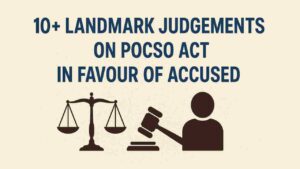The Salient Features of the Sexual Harassment of Women at Workplace (Prevention, Prohibition and Redressal) Act, 2013 include a broad definition of sexual harassment, mandatory Internal Complaints Committees, timely redressal, employer responsibilities, confidentiality, and penalties for non-compliance, ensuring women’s workplace safety.
Today, where the role of women in the workforce continues to grow across sectors, ensuring their safety and dignity at the workplace has become more critical than ever. Yet, sexual harassment remains a persistent and deeply troubling issue that threatens not only an individual’s well-being but also the ethos of equality and justice in the professional sphere.
Recognizing the urgent need for a robust legal framework, the Indian Parliament enacted the Sexual Harassment of Women at Workplace (Prevention, Prohibition and Redressal) Act, 2013, popularly known as the POSH Act 2013, a landmark legislation designed to uphold a woman’s right to a secure and harassment-free work environment.
Rooted in the principles of the Indian Constitution and aligned with international commitments like the CEDAW, this Act stands as a powerful instrument for both prevention and redressal of workplace sexual harassment.
Salient Features of the Sexual Harassment of Women at Workplace (Prevention, Prohibition and Redressal) Act, 2013
#1 Purpose and Scope of the Act
This Act was enacted to protect women from sexual harassment at their workplace. It recognizes that such harassment violates a woman’s fundamental rights to equality under Articles 14 and 15, her right to live with dignity under Article 21, and her right to practice any profession or occupation under Article 19(1)(g) of the Constitution of India.
The Act ensures that women have a safe and secure environment at work, free from unwelcome behavior of a sexual nature. It also reflects India’s commitment to international conventions, particularly the Convention on the Elimination of All Forms of Discrimination Against Women (CEDAW).
#2 Comprehensive Definitions
The Act provides clear and inclusive definitions to cover a wide range of situations and roles. “Sexual Harassment“ under the Act includes not only overt physical advances but also subtle or implied actions like sexually colored remarks or showing pornography.
It goes beyond just physical actions to include verbal and non-verbal conduct of a sexual nature that is unwelcome. Importantly, the Act also defines terms like “aggrieved woman”, “workplace”, and “employee” in a broad manner to cover various sectors and types of employment, including part-time, contractual, and even voluntary workers. This ensures wide protection and applicability.
#3 Constitution of Internal and Local Complaints Committees
To address complaints efficiently, the Act mandates the formation of Internal Complaints Committees (ICC) in every organization or office with ten or more employees. The committee must be chaired by a senior woman employee and should include members experienced in law or social work.
For establishments with fewer than ten employees or when the complaint is against the employer, a Local Complaints Committee (LCC) must be set up by the District Officer. These committees ensure that even women in small or informal workplaces have a platform for grievance redressal.
#4 Filing and Handling of Complaints
An aggrieved woman can file a complaint of sexual harassment within three months of the incident, with extensions allowed under special circumstances. If she cannot file it herself due to physical or mental incapacity, her legal heir or another authorized person may do so.
The Act also provides for conciliation (if the woman desires) before initiating a formal inquiry, although monetary settlements are not allowed through this route. The inquiry process must be completed within 90 days, and both the complainant and the respondent are to be heard fairly.
#5 Inquiry and Consequences
Following the inquiry, the committee must submit a report within 10 days, and based on the findings, appropriate actions must be taken within 60 days. If the allegations are proven, actions can range from treating the offense as misconduct under service rules to monetary compensation to the victim.
In cases involving criminal offenses, the complaint can also be forwarded to the police for legal action under relevant sections of the Indian Penal Code.
#6 Protection Against False Complaints
To discourage misuse, the Act also includes provisions for penalizing false or malicious complaints. However, it clearly states that the inability to prove a complaint does not imply it was made with malicious intent.
Before recommending action against a complainant, the committee must conduct a full inquiry to establish malicious intent or falsehood.
#7 Employer’s Responsibilities
Employers are mandated to take proactive measures to prevent sexual harassment. These include:
- Ensuring a safe work environment
- Displaying rules and penalties against harassment
- Organizing awareness and training programs
- Assisting the ICC or LCC
- Treating sexual harassment as misconduct under service rules
The employer must also facilitate the victim in filing criminal complaints if necessary and ensure timely action and reporting.
#8 Role of the District Officer
The District Officer, appointed by the appropriate government, has the responsibility to monitor the functioning of the Local Committees, engage NGOs for awareness generation, and ensure compliance with the law at the local level.
They act as the administrative backbone supporting the implementation of the Act in smaller or decentralized workplaces.
#9 Confidentiality Provisions
The Act contains strong provisions to protect the identity and privacy of the complainant, respondent, and witnesses. The contents of the complaint and the proceedings of the inquiry are not to be made public in any manner, including through the media or online platforms. Only outcomes, without disclosing identities, can be shared to promote transparency and deterrence.
#10 Penalties and Legal Provisions
Failure to comply with the provisions of the Act, such as not forming a committee or not acting on its recommendations, can lead to a fine of up to ₹50,000. Repeated non-compliance may lead to cancellation of business licenses or registrations. The Act is non-derogatory, meaning it works in addition to other laws and doesn’t override existing legal protections.
#11 Extended Definition of Workplace
A unique strength of this Act is its inclusive and wide-ranging definition of “workplace”. It doesn’t just include conventional office spaces but also:
- Places visited by the employee during the course of employment (e.g., client locations, travel for work).
- Transportation is provided by the employer.
- Residences where domestic workers are employed.
- Any location where women may be working in a professional, vocational, educational, or sports context.
This ensures that women are protected not only within the four walls of their office but in all professional interactions and locations.
#12 Empowerment of Unorganized Sector Workers
The Act gives special attention to women working in the unorganized sector (with less than 10 employees), who are often more vulnerable due to informal employment arrangements.
Through the establishment of Local Complaints Committees, the Act extends its protective net to domestic workers, street vendors, and others who typically have little to no workplace structure or HR support.
#13 Annual Reporting Obligations
To ensure transparency and accountability:
- Internal and Local Committees must prepare an annual report detailing the number of cases and their outcomes.
- Employers are required to include these details in their organization’s annual report or send them to the District Officer if no such report is prepared.
- These provisions promote institutional accountability and give authorities visibility into how seriously workplaces are addressing harassment.
#14 Government’s Role in Awareness and Training
The Act puts the onus on both employers and the government to promote awareness, like Employers must organize training and sensitization programs for employees and committee members.
Governments (both state and central) are tasked with:
- Developing IEC (Information, Education, and Communication) materials
- Partnering with NGOs to raise awareness
- Monitoring data on sexual harassment cases
#15 Timely Redressal with Civil Court Powers
The Internal and Local Committees are given powers similar to civil courts:
- They can summon witnesses, enforce attendance, and demand document production.
- This empowers them to conduct inquiries seriously and ensures a level of procedural rigor.
They are also bound by strict timelines (90 days for inquiry, 10 days for reporting), which helps avoid long delays that often discourage victims from pursuing justice.
#16 Right to Appeal
Any aggrieved party, whether the complainant or the respondent, can file an appeal within 90 days of the committee’s decision. This can be to a court or tribunal, ensuring that decisions can be reviewed fairly and further safeguarding the interests of both parties.
#17 Remedies and Compensation
The Act provides for monetary compensation to the victim, based on factors like:
- Emotional trauma
- Medical expenses
- Loss of career opportunities
- Income of the respondent
This recognizes the real-life impact of harassment and goes beyond symbolic punishment to offer actual relief.
Landmark Cases on POSH Act 2013
Vishaka and Others v. State of Rajasthan (1997)
Although predating the POSH Act, this landmark Supreme Court judgment is the cornerstone for workplace sexual harassment laws in India. The case arose from the gang-rape of Bhanwari Devi, a social worker in Rajasthan, who faced retaliation for preventing a child marriage. The Supreme Court, recognizing the absence of legislative protection, issued the Vishaka Guidelines, mandating employers to prevent sexual harassment, establish complaint mechanisms, and ensure gender equality. These guidelines formed the foundation for the POSH Act, 2013, and emphasized the constitutional right to a safe workplace under Articles 14, 15, and 21. The judgment drew from international conventions like CEDAW, setting a precedent for judicial activism in addressing workplace harassment.
Apparel Export Promotion Council v. A.K. Chopra (1999)
This Supreme Court case, decided before the POSH Act but relevant to its principles, addressed sexual harassment in the context of workplace misconduct. The respondent, a senior officer, was dismissed for sexually harassing a female employee. The Court upheld the dismissal, ruling that sexual harassment violates a woman’s fundamental rights to equality and dignity under Articles 14, 15, and 21. It clarified that even attempts to molest, without physical contact, constitute harassment. This case reinforced the need for strict employer action against harassment, aligning with the objectives later codified in the POSH Act, particularly regarding employer accountability and the broad definition of harassment.
Medha Kotwal Lele v. Union of India (2013)
This Supreme Court case was instrumental in highlighting implementation gaps in the Vishaka Guidelines and pushing for the enforcement of the POSH Act, which had just come into force. The petitioners sought better compliance with the Vishaka Guidelines across states and union territories. The Court criticized the lack of complaint committees and inadequate awareness, directing states to ensure proper mechanisms for addressing sexual harassment. It emphasized the need for Internal Complaints Committees (ICCs) and Local Complaints Committees (LCCs), reinforcing the POSH Act’s mandate for structured redressal mechanisms. This judgment bridged the transition from the Vishaka Guidelines to the POSH Act, ensuring its effective implementation.
Punjab and Sind Bank v. Durgesh Kuwar (2020)
In this Supreme Court case, the Court addressed the intersection of sexual harassment and workplace retaliation. The respondent, a bank employee, alleged sexual harassment by a senior officer and faced transfer orders after raising complaints. The Court set aside the transfer, ruling that it was retaliatory and violated the principles of natural justice. This case underscored the POSH Act’s provisions against retaliation (Section 16) and emphasized the employer’s duty to protect complainants from adverse actions, reinforcing the Act’s objective of ensuring a safe and non-hostile work environment.
Aureliano Fernandes v. State of Goa (2023)
A significant recent Supreme Court judgment, this case exposed serious lapses in the implementation of the POSH Act. The Court expressed concern over the “abysmal state of affairs” in compliance, noting that only 16 out of 30 national sports federations had constituted ICCs as mandated. The case involved allegations of sexual harassment against a senior official, with procedural irregularities in the inquiry process. The Court directed strict adherence to the POSH Act, including proper ICC constitution, timely inquiries, and awareness programs. It reiterated the employer’s duty under Section 19 to ensure a safe workplace and highlighted systemic failures, calling for robust enforcement mechanisms.
These landmark cases collectively shaped the interpretation and enforcement of the POSH Act, 2013. From laying the groundwork (Vishaka), defining harassment broadly (A.K. Chopra), ensuring compliance (Medha Kotwal), protecting against retaliation (Durgesh Kuwar), to addressing systemic failures (Aureliano Fernandes), these judgments have reinforced the Act’s objectives of prevention, prohibition, and redressal of workplace sexual harassment.
Verdict: A Bold Step Toward Safer Workplaces for Women
The Sexual Harassment of Women at Workplace (Prevention, Prohibition and Redressal) Act, 2013 is more than just a legal safeguard, it’s a powerful declaration that dignity, safety, and equality are non-negotiable at the workplace. With its comprehensive framework and strict enforcement mechanisms, the Act empowers women to speak up, ensures accountability, and compels organizations to build a culture of respect.
It’s not just a law. It’s a movement towards transforming Indian workplaces into inclusive, secure, and equitable spaces for all.
Follow The Legal QnA For More Updates…















